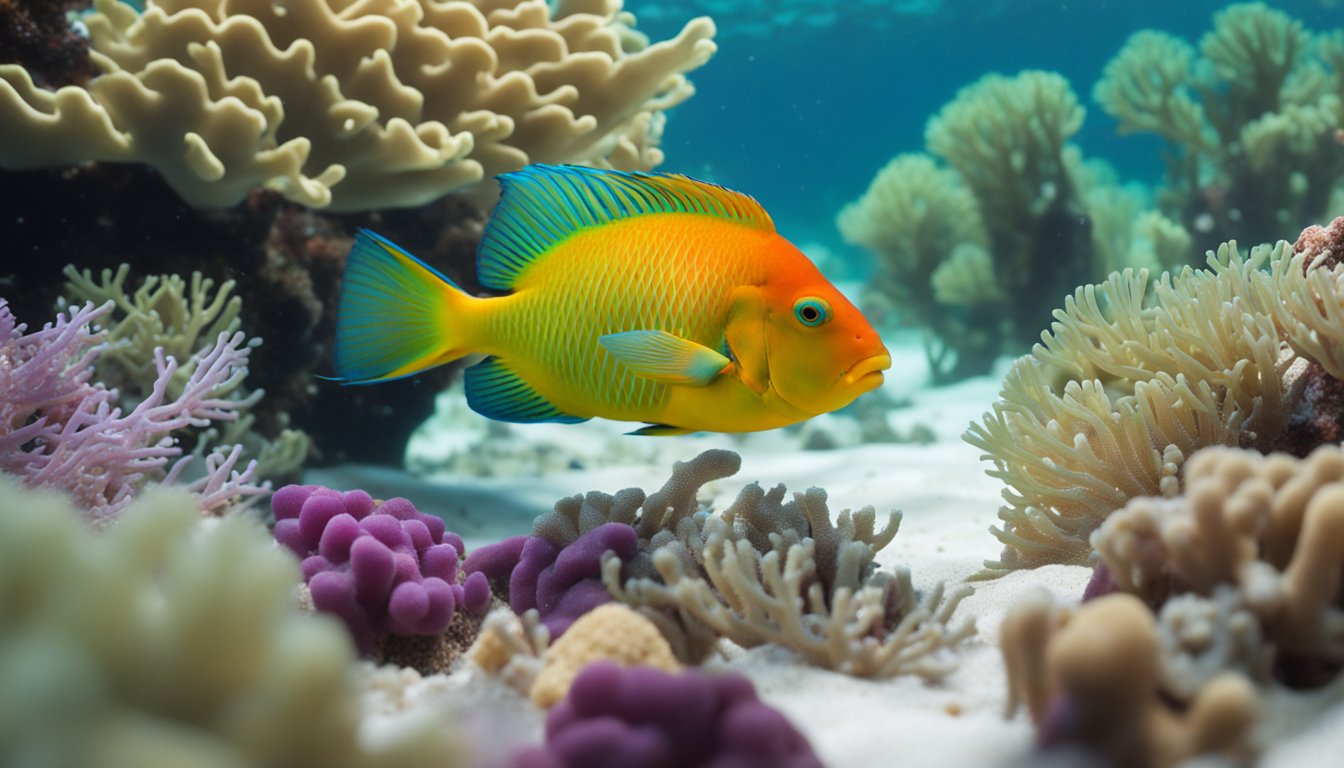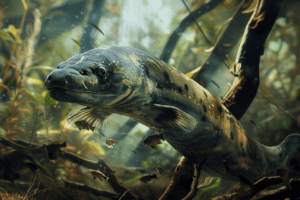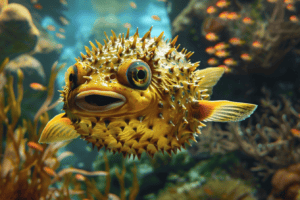Parrotfish are a colorful and fascinating group of fish that play a crucial role in coral reef ecosystems.
These fish are known for their parrot-like beaks, which they use to scrape algae off of coral reefs.
While this may seem like a small task, parrotfish actually play a much larger role in the health and survival of coral reefs.

Parrotfish are considered to be the “rulers of the reef” because of their ability to control the growth of algae on coral reefs.
Without parrotfish, algae would grow unchecked and smother the coral, leading to the decline and eventual death of the reef.
In addition to their role in controlling algae, parrotfish also help to create new coral reefs by producing large amounts of sand as they scrape algae off of the reef.
This sand is then used by other marine organisms to build new coral reefs.
Despite their important role in coral reef ecosystems, parrotfish populations are declining due to overfishing and habitat destruction.
It is important to understand the vital role that parrotfish play in coral reef ecosystems and to take action to protect these fascinating creatures.
By learning more about parrotfish and their role in coral reef ecosystems, we can work to ensure the health and survival of these important marine habitats for generations to come.
Parrotfish: Architects of the Reef
Species and Diversity
Parrotfish are a diverse family of fish that play an essential role in coral reef ecosystems.
There are over 80 species of parrotfish, each with unique physical characteristics and behaviors that contribute to the health and survival of the reef.
Some of the most common species include the stoplight parrotfish, the queen parrotfish, and the rainbow parrotfish.
These fish are found in tropical and subtropical waters around the world, from the Caribbean to the Indo-Pacific.
They come in a wide range of sizes, from the tiny bluelip parrotfish, which reaches only 4 inches in length, to the humphead parrotfish, which can grow up to 4 feet long.
Physical Characteristics
One of the most distinctive features of parrotfish is their beak-like mouth, which is specially adapted for scraping algae and other small organisms off coral and rocks.
This beak is made up of fused teeth that are constantly growing and being worn down as the fish feeds.
In addition to their unique mouths, parrotfish are also known for their vibrant colors and patterns.
Many species have bright greens, blues, and yellows, which help them blend in with their surroundings and attract mates.
But perhaps the most important physical characteristic of parrotfish is their ability to produce and excrete large amounts of calcium carbonate.
This substance is the same material that makes up the hard outer skeleton of coral reefs, and parrotfish play a crucial role in maintaining and building these structures.
As parrotfish graze on algae and other organisms, they ingest small pieces of coral and other materials.
These materials are broken down in the fish’s digestive system, and the calcium carbonate is excreted as sand, which helps to build and stabilize the reef.
Overall, parrotfish are fascinating creatures that are essential to the health and survival of coral reef ecosystems.
Their unique physical characteristics and behaviors make them true architects of the reef, shaping and maintaining one of the most diverse and important ecosystems on the planet.
Ecosystem Impact

Parrotfish are a vital part of coral reef ecosystems, playing a crucial role in maintaining the health and balance of these underwater wonderlands.
Their impact can be seen in two main areas: coral grazing and sand production, and bioerosion and reef health.
Coral Grazing and Sand Production
Parrotfish are known for their unique feeding habits, which involve scraping algae and small organisms from the surface of corals.
This process, known as coral grazing, helps to keep the corals clean and healthy, allowing them to grow and reproduce.
In addition, parrotfish have powerful teeth that can crush and grind the hard coral skeleton, producing large amounts of sand that are crucial for the formation of beaches and islands.
Did you know that a single parrotfish can produce up to 90 kilograms of sand per year? That’s enough to fill a small swimming pool!
Without parrotfish, the sandy beaches and islands that we enjoy today would not exist.
Bioerosion and Reef Health
While parrotfish are important for coral growth and sand production, they also play a key role in bioerosion, or the breakdown of coral structures.
Parrotfish use their strong beaks to scrape and bite chunks of coral, creating small holes and crevices that provide shelter and hiding places for other reef creatures.
This process also helps to break down old coral structures, making room for new growth.
However, if there are too few parrotfish in an area, the bioerosion process can become unbalanced, leading to an overgrowth of algae and other organisms that can harm the coral.
This can lead to a decline in overall reef health, which can have far-reaching consequences for the entire ecosystem.
In conclusion, parrotfish are a vital part of coral reef ecosystems, playing a crucial role in maintaining the health and balance of these underwater wonderlands.
By understanding their impact on the ecosystem, we can better protect and preserve these fragile environments for future generations to enjoy.
Threats to Parrotfish Populations

Parrotfish play a vital role in maintaining the health of coral reefs.
Unfortunately, these colorful fish are facing several threats that are putting their populations at risk.
In this section, we will discuss the major threats to parrotfish populations and their impact on coral ecosystems.
Overfishing and Its Effects
Overfishing is one of the biggest threats to parrotfish populations.
These fish are highly sought after in the seafood industry, and their colorful scales and unique appearance make them a popular choice in the aquarium trade.
As a result, many species of parrotfish are being overfished, which is causing their populations to decline.
The loss of parrotfish has a significant impact on coral ecosystems.
Parrotfish are herbivores, and they play a crucial role in keeping algae levels in check.
Without parrotfish, algae can quickly overgrow and smother coral, leading to the decline and eventual death of the reef.
Habitat Destruction
Parrotfish also face threats from habitat destruction.
Coral reefs are incredibly sensitive ecosystems, and any disturbance can have a significant impact on their health.
Human activities such as dredging, coastal development, and pollution can damage or destroy coral reefs, which in turn affects the parrotfish populations that rely on them.
Climate Change Challenges
Climate change is another significant threat to parrotfish populations.
Rising sea temperatures and ocean acidification are causing coral reefs to bleach and die.
This loss of habitat has a direct impact on parrotfish populations, as they rely on coral reefs for food and shelter.
In addition to the loss of habitat, climate change is also affecting the behavior and physiology of parrotfish.
Warmer waters can cause parrotfish to spawn earlier in the year, which can disrupt the delicate balance of the ecosystem.
Changes in pH levels can also affect the development of parrotfish larvae, making it harder for them to survive and thrive.
In conclusion, parrotfish populations are facing several threats that are putting their survival at risk.
Overfishing, habitat destruction, and climate change are all having a significant impact on these colorful fish and the coral ecosystems they call home.
It is essential that we take action to protect parrotfish populations and the delicate balance of life on coral reefs.
Conservation Efforts

Marine Protected Areas
One of the most effective ways to protect coral reef ecosystems is through the establishment of marine protected areas (MPAs).
MPAs are designated areas where fishing and other human activities are restricted or prohibited to allow marine life to thrive.
Parrotfish are often a target for fishing due to their importance as a food source, but MPAs can provide a safe haven for these important reef rulers.
Studies have shown that MPAs can increase the biomass of parrotfish and other reef fish, leading to healthier and more resilient coral ecosystems.
In fact, a study in the Caribbean found that MPAs with high levels of parrotfish biomass had 50% less coral disease than areas with low parrotfish biomass.
Fishing Regulations
In addition to MPAs, fishing regulations can also help protect parrotfish populations.
Many countries have implemented size limits, bag limits, and seasonal closures for parrotfish to prevent overfishing.
These regulations help ensure that parrotfish are able to reproduce and maintain healthy populations.
However, enforcement of fishing regulations can be a challenge.
Illegal fishing and poaching can still occur, and education and awareness campaigns are needed to help fishermen understand the importance of protecting parrotfish and other reef species.
Public Awareness and Education
Public awareness and education are crucial components of parrotfish conservation efforts.
Many people are unaware of the important role parrotfish play in coral reef ecosystems, and the impact that human activities can have on these ecosystems.
Education campaigns can help raise awareness about the importance of parrotfish and other reef species, and encourage individuals to take action to protect them.
This can include reducing plastic use, supporting sustainable fishing practices, and advocating for the establishment of MPAs and fishing regulations.
By working together to protect parrotfish and other reef rulers, we can help ensure the health and resilience of coral reef ecosystems for generations to come.
Frequently Asked Questions

How do parrotfish contribute to the health of coral reefs?
Parrotfish play a crucial role in maintaining the health of coral reefs.
They are known as “ecosystem engineers” because they help to create and maintain the habitats that support a diverse range of marine life.
Parrotfish graze on algae that grow on the reef, which helps to prevent the algae from overgrowing and smothering the coral.
They also produce a lot of coral sand as they scrape algae off the reef, which helps to create new habitats for other marine species.
In addition, parrotfish are important sources of nutrients for other marine organisms.
What are the consequences for coral reefs if parrotfish populations decline?
If parrotfish populations decline, it can have serious consequences for coral reefs.
Algae can overgrow and smother the coral, which can lead to a decline in the health and diversity of the reef ecosystem.
Without parrotfish to produce coral sand, there may be less habitat for other marine organisms.
In addition, the loss of parrotfish as a food source can have a ripple effect throughout the food chain, affecting other species that rely on them for nutrients.
In what ways do parrotfish interact with their coral environment?
Parrotfish interact with their coral environment in several ways. They graze on algae, which helps to prevent overgrowth and smothering of the coral.
As they scrape the algae off the reef, they also produce coral sand, which helps to create new habitats for other marine species.
Parrotfish also help to break down dead coral, which helps to recycle nutrients back into the ecosystem.
What predators threaten the survival of parrotfish in the reef?
Parrotfish have several natural predators in the reef ecosystem, including sharks, barracudas, and groupers.
In addition, humans also pose a threat to parrotfish populations through overfishing and habitat destruction.
How does the diet of parrotfish affect reef formation and maintenance?
The diet of parrotfish plays a crucial role in reef formation and maintenance.
Parrotfish graze on algae that grow on the reef, which helps to prevent overgrowth and smothering of the coral.
As they scrape the algae off the reef, they also produce coral sand, which helps to create new habitats for other marine species.
In addition, parrotfish help to break down dead coral, which helps to recycle nutrients back into the ecosystem.
What conservation measures are in place to protect parrotfish and their reef habitats?
There are several conservation measures in place to protect parrotfish and their reef habitats.
These include regulations on fishing and habitat destruction, as well as the establishment of marine protected areas.
In addition, there are efforts to educate people about the importance of parrotfish and the role they play in maintaining healthy reef ecosystems.
By working together, we can help to ensure that parrotfish and coral reefs continue to thrive for generations to come.









